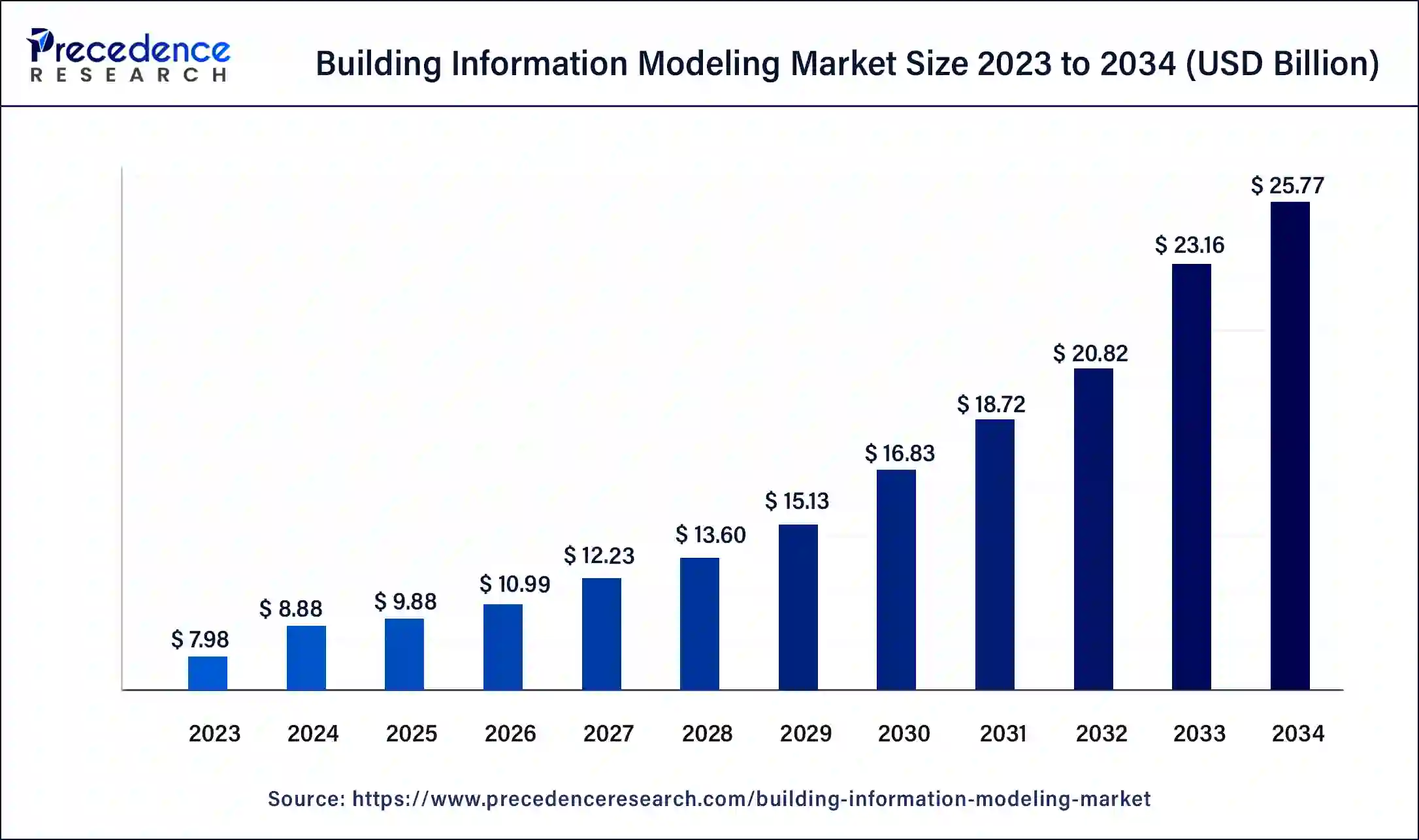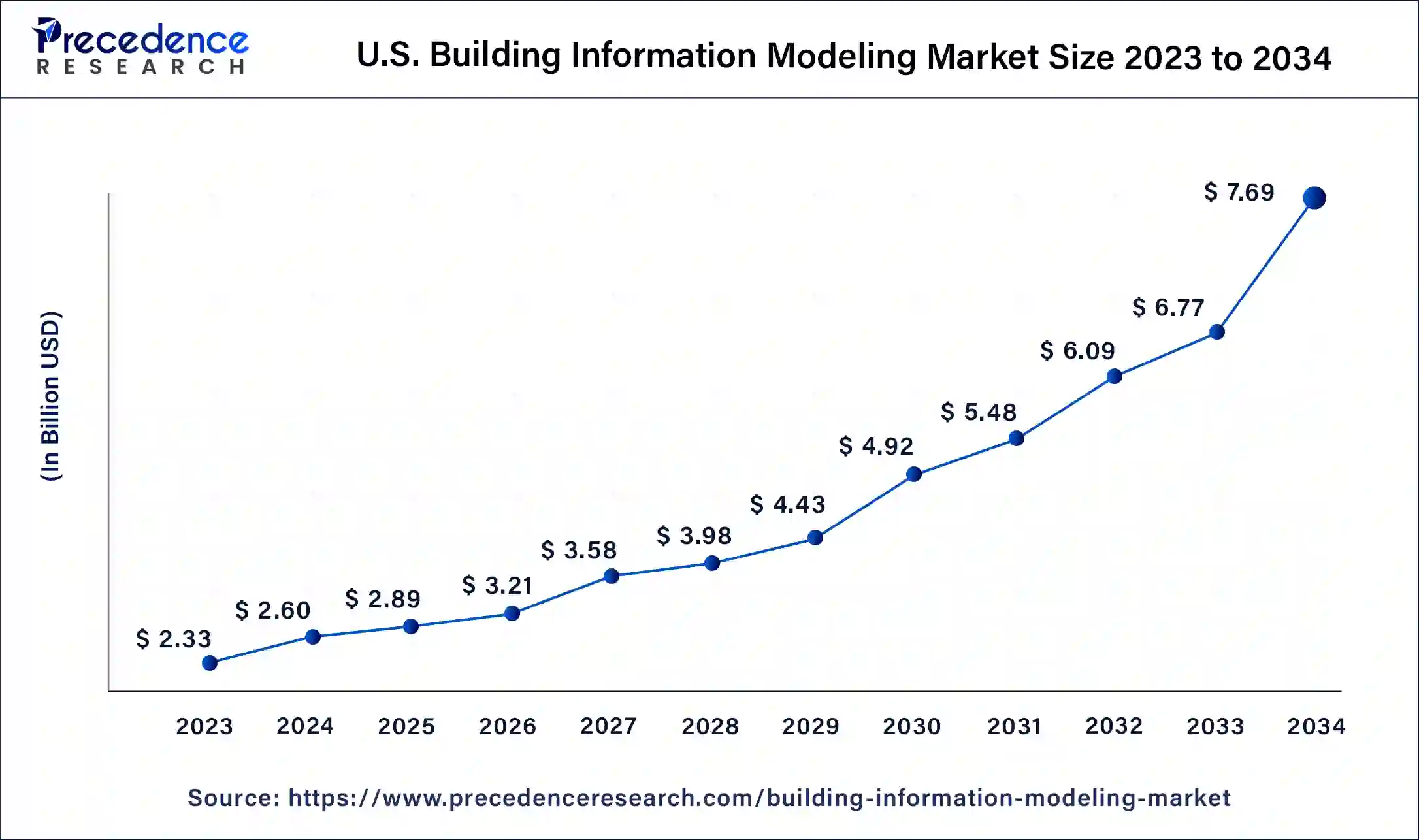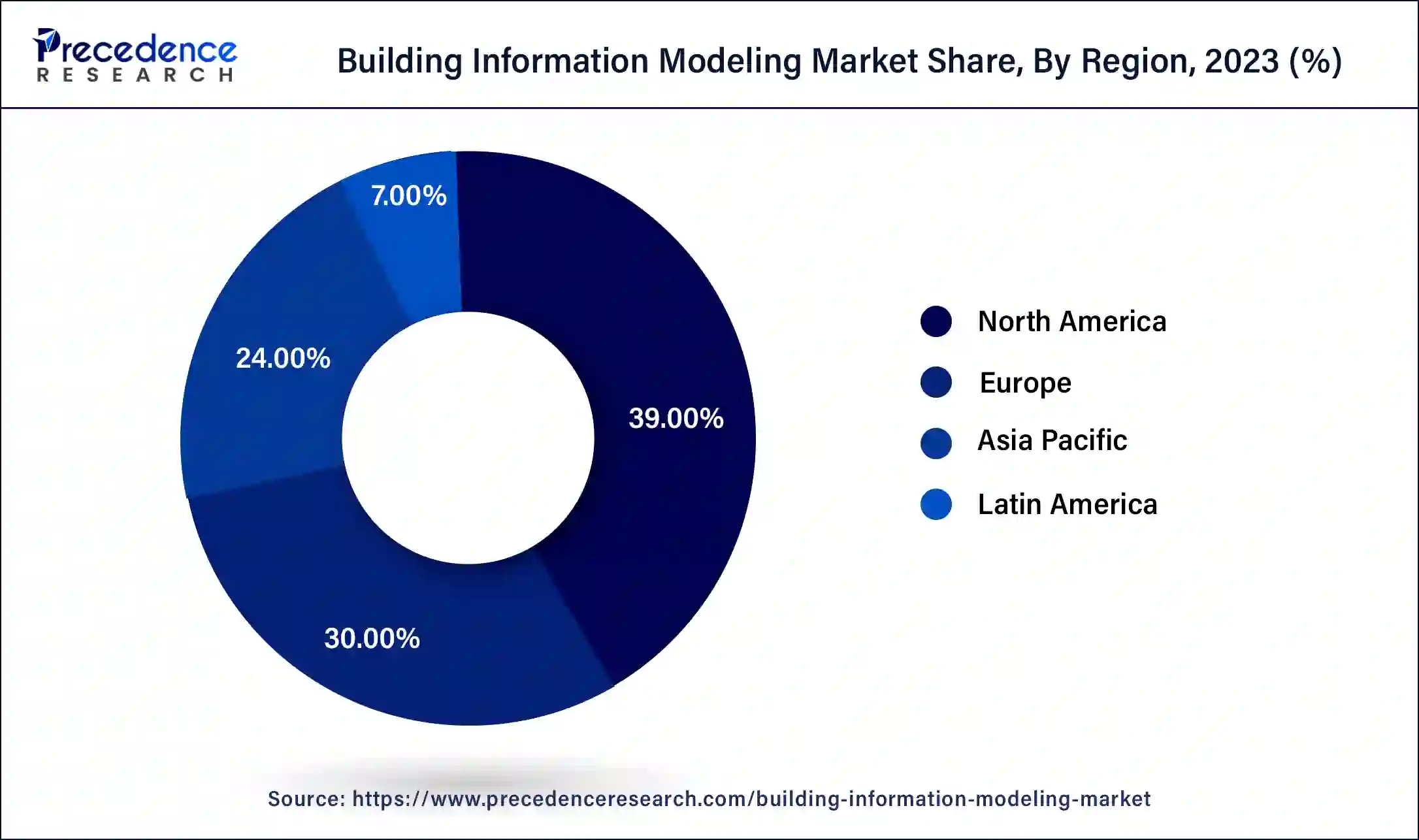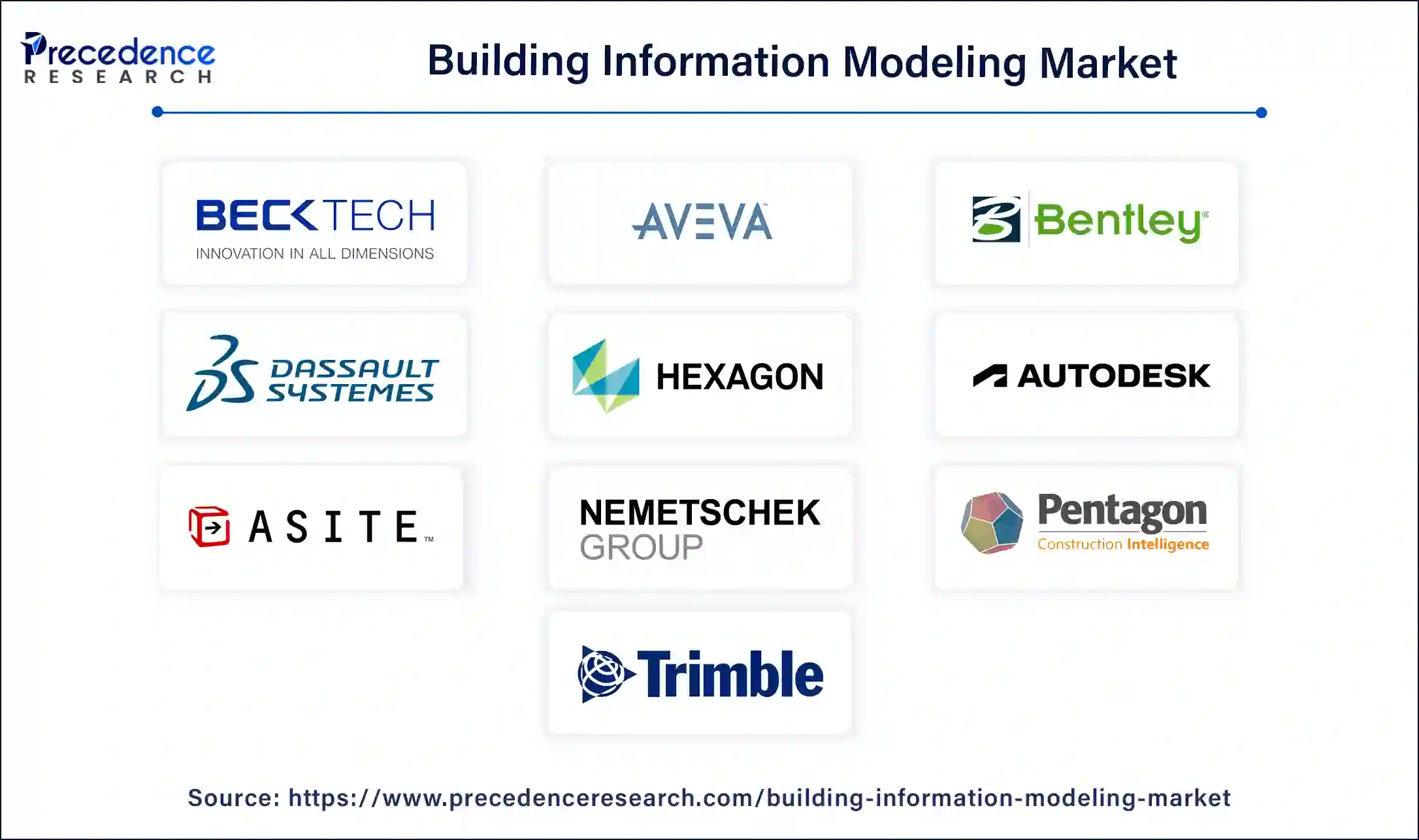January 2025
Building Information Modeling Market (By Deployment Mode: On-premises, Cloud; By Building Type: Commercial, Residential; By Component: Solution, Service; By Application: Planning and Modelling, Construction and Design, Asset Management, Building System Analysis and Maintenance Scheduling; By End-user: Architects/Engineers, Contractors, Others) - Global Industry Analysis, Size, Share, Growth, Trends, Regional Outlook, and Forecast 2024-2034
The global building information modeling market size was USD 7.98 billion in 2023, calculated at USD 8.88 billion in 2024 and is expected to reach around USD 25.77 billion by 2034. The market is expanding at a solid CAGR of 11.24% over the forecast period 2024 to 2034. The North America building information modeling market size reached USD 3.11 billion in 2023. The building information modeling market is driven by a greater focus on energy efficiency and sustainability.

The U.S. building information modeling market size was exhibited at USD 2.33 billion in 2023 and is projected to be worth around USD 7.69 billion by 2034, poised to grow at a CAGR of 11.46% from 2024 to 2034.

North America dominated the building information modeling market in 2023. The United States adopted BIM technology early in North America. Major North American countries have witnessed a surge in the development of BIM software and methodology, leading to significant investments in research and development. North America's top research and academic universities concentration has produced a workforce with advanced BIM skills. This architecture of education fosters ongoing innovation and the creation of fresh BIM methods and applications.

Asia-Pacific is observed to be the fastest growing in the building information modeling market during the forecast period. Asia-Pacific is home to several nations making significant investments in infrastructure initiatives like smart cities, transit networks, and commercial expansions. The use of BIM is growing to simplify the design, construction, and management of these intricate projects. Through the reduction of rework, optimization of resource usage, and improvement of project timeliness, BIM provides significant cost efficiencies. Furthermore, the region is increasingly emphasizing sustainable construction methods, and BIM makes it easier to design and build ecologically friendly structures by providing improved simulation and visualization capabilities.
The building information modeling market includes the products, services, and technology used to design, administer, and distribute digital representations of the functional and physical aspects of locations. Stakeholders may work together and cooperate throughout the lifecycle of a building or infrastructure project, from planning and design to construction, operation, and maintenance, due to these representations or models, which comprise intricate 3D models and related metadata.
Stakeholders may see the project in depth with 3D models before construction starts. This aids in early project lifecycle decision-making, design optimization, and identifying possible problems. By enabling the examination of energy performance, material usage, and environmental impact, BIM promotes sustainable construction practices. This aids in the design of more ecologically and energy-conscious buildings. IM assists in ensuring that designs adhere to building codes and regulatory norms. It also helps with risk management by tracking modifications during the project and offering thorough documentation.
| Report Coverage | Details |
| Market Size by 2034 | USD 25.77 Billion |
| Market Size in 2023 | USD 7.98 Billion |
| Market Size in 2024 | USD 8.88 Billion |
| Market Growth Rate from 2024 to 2034 | CAGR of 11.24% |
| Largest Market | North America |
| Base Year | 2023 |
| Forecast Period | 2024 to 2034 |
| Segments Covered | Deployment Mode, Building Type, Component, Application, End-user, and Regions |
| Regions Covered | North America, Europe, Asia-Pacific, Latin America, and Middle East & Africa |
Best 3D Construction Software
| Sr.No. | Software | Applications |
| 1. | Revit | By producing a digital three-dimensional model of a building, it thoroughly depicts all of its constituent parts and physical structure. |
| 2. | Rhino7 | It applies to many design disciplines, such as architecture, automobile design, and industrial design. |
| 3. | Maya | It has a strong rendering engine for realistic settings and excellent graphics. |
| 4. | Blender | Its toolkit is extensive and includes tools for 3D modeling, animation, rendering, simulation, compositing, and video editing. |
| 5. | Cinema 3D | Its smooth integration allows for effective data sharing and collaboration with other widely used programs and file types. |
Expanding construction activities
BIM helps contractors, architects, engineers, and stakeholders collaborate more effectively by offering a shared digital picture of the project. This lowers errors and miscommunication. BIM's usefulness in construction activities is increased by its smooth integration with other cutting-edge technologies, including artificial intelligence (AI), virtual reality (VR), and the Internet of Things (IoT). The industry's adoption of BIM has been fueled by many government mandates requiring the use of BIM for public construction projects to guarantee efficiency and transparency. This drives the growth of the building information modeling market.
High implementation cost
The cost of BIM software licensing is high. Prominent BIM programs such as Bentley Systems, Autodesk Revit, and ArchiCAD have significant upfront expenditures that may be unaffordable for small and medium-sized businesses. Sturdy hardware is needed for BIM to function well. This frequently entails making higher-end server and computer purchases, which raises the initial cost. Upgrading IT infrastructure, such as network systems and storage solutions, may be necessary for businesses to manage the massive data volumes produced by BIM procedures. This limits the growth of the building information modeling market.
Advancements in design and modeling technologies
Improvements in simulation and analytic technologies enable more precise modeling of building performance, including thermal comfort, structural integrity, and energy efficiency. These tools can save money and time by spotting problems before the building starts. Example: Comprehensive analytical capabilities are provided by tools such as IES VE and Green Building Studio, which can simulate different environmental conditions and their effects on building performance.
Cloud-based BIM solutions make remote collaboration more accessible, which is especially helpful in today's workplace. These technologies improve Project coordination, which facilitates real-time data sharing and communication. This opens an opportunity for the growth of the building information modeling market.
The on-premises segment is observed to be the fastest growing in the building information modeling market. On-premises BIM systems provide more data control, which is essential for sectors like government projects and critical infrastructure that have strict regulations regarding data security and privacy. Many businesses must abide by national and international data protection laws, which are simpler to administer when using on-premises software. These solutions can be changed to satisfy legal obligations.
The cloud segment shows a notable share in the building information modeling market during the forecast period. Real-time collaboration between project stakeholders, such as architects, engineers, contractors, and owners, is made more accessible by cloud-based BIM tools. Team members can concurrently view, edit, and share information from any place by centralizing the BIM data on the cloud. Decision-making processes are accelerated, errors are decreased, and communication is improved. Cloud-based BIM platforms offer the means to meet the growing digital standards and regulations the construction sector must adhere to. Numerous cloud BIM solutions are made by industry standards, guaranteeing that projects fulfill legal requirements and quality standards.
The residential segment dominated the building information modeling market in 2023. Using BIM, designers and architects can produce incredibly accurate 3D models of residential structures. This lowers uncertainty and improves decision-making by enabling homeowners and other stakeholders to see the finished project before construction starts. Residential projects frequently call for a high level of customization to satisfy the homeowners' unique requirements and tastes. BIM makes it simple to adjust and customize designs during the design process, ensuring that the finished product meets client expectations.
The commercial segment is expected to grow at a notable rate in the building information modeling market during the forecast period. Commercial construction firms have adopted and integrated BIM workflows, facilitated by BIM software and tools advancements. For commercial projects particularly, these tools' features, such as clash detection, 4D scheduling, and 5D cost estimation, are quite helpful. Other cutting-edge technologies, such as augmented reality (AR), artificial intelligence (AI), and the Internet of Things (IoT), are being combined with BIM. The possibilities of BIM are improved by these interfaces, increasing its value for commercial development.
The solution segment dominated in the building information modeling market in 2023. BIM solutions provide accurate modeling and analysis, which increases project efficiency and accuracy. They make it possible to combine different kinds of data into a single model, which aids in the early detection of possible problems during the design stage. This lessens the possibility of expensive mistakes and rework while building. Project planning and management are further improved by the capacity to visualize projects in 3D, 4D (time), and even 5D (cost). This improves resource allocation and time management.
The service segment shows significant growth in the building information modeling market during the forecast period. Services like consultancy, training, and support are in greater demand as BIM becomes increasingly integrated into architectural and construction. These services are necessary for businesses to successfully incorporate BIM into their operations. The development of BIM is being driven, in part, by government mandates and large-scale infrastructure projects, especially in industrialized and developing nations. As a result, more specialist services are required to guarantee efficiency and compliance.
The planning and modeling segment held a significant share in the building information modeling market in 2023. Planning and modeling are essential to the construction project lifecycle from the beginning to the end. This section's task is to make intricate 3D models that incorporate structural, architectural, and MEP (mechanical, electrical, and plumbing) components. By acting as a single source of truth, these models ensure that everyone involved in the project knows its specifics.
The construction and design segment are expected to grow at a notable rate in the building information modeling market during the forecast period. The use of BIM is expanding across a range of construction projects, such as infrastructural, commercial, and residential complexes. This is motivated by the need for improved stakeholder participation, more effective project management, and the capacity to model and simulate building designs before construction. BIM encourages better cooperation and communication between architects, engineers, contractors, and owners in construction projects. BIM creates a common platform for project information access, which minimizes misconceptions and improves decision-making. The management of intricate construction projects is becoming increasingly dependent on this collaborative approach, which is helping to expand BIM use.
The architects /engineers segment led the building information modeling market in 2023. Engineers and architects were some of the first professionals to use BIM software. Their early acceptance made it easier to switch from more sophisticated BIM platforms to more conventional CAD (Computer-Aided Design) systems. Engineers and architects may find and fix problems early in the design process using the sophisticated clash detection technologies that BIM offers. This lessens the possibility of expensive adjustments and building delays. Early in the design process, BIM assists engineers and architects in identifying possible risks by providing a thorough project view. Unexpected problems during construction are less likely to occur when risk management is done proactively.
The contractors segment shows a significant growth in the building information modeling market during the forecast period. Due to its ability to streamline the project planning, design, construction, and maintenance stages, BIM is being adopted by contractors more and more. Using BIM, contractors may digitally depict the building process, improving stakeholder coordination and communication. Other cutting-edge technologies like augmented reality (AR), virtual reality (VR), and the Internet of Things (IoT) all work nicely with BIM. The augmentation of project visualization, communication, and management capabilities through this integration is appealing to contractors who want to use cutting-edge solutions to complete projects.

Segments Covered in the Report
By Deployment Mode
By Building Type
By Component
By Application
By End-user
By Geography
For inquiries regarding discounts, bulk purchases, or customization requests, please contact us at sales@precedenceresearch.com
No cookie-cutter, only authentic analysis – take the 1st step to become a Precedence Research client
January 2025
April 2025
January 2025
August 2024